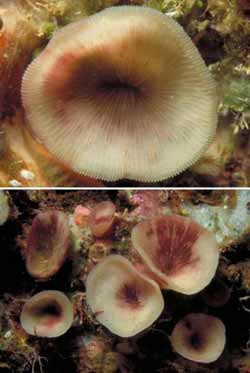A new cave-dwelling reef coral discovered in the Indo-Pacific

This is the new coral species living on the ceilings of caves in tropical coral reefs.<br><br>Credit: Dr. Bert W. Hoeksema / Naturalis<br>
Coral specialist Dr. Bert W. Hoeksema of Naturalis Biodiversity Center in Leiden, The Netherlands, recently published the description of a new coral species that lives on the ceilings of caves in Indo-Pacific coral reefs.
It differs from its closest relatives by its small polyp size and by the absence of symbiotic algae, so-called zooxanthellae. Its distribution range overlaps with the Coral Triangle, an area that is famous for its high marine species richness. Marine zoologists of Naturalis visit this area frequently to explore its marine biodiversity.
Reef corals in shallow tropical seas normally need the symbiotic algae for their survival and growth. Without these algae, many coral reefs would not exist. During periods of elevated seawater temperature, most reef corals lose their algae, which is visible as a dramatic whitening of the reefs, a coral disease known as bleaching.
Most reef corals generally do not occur over 40 m depth, a twilight zone where sunlight is not bright anymore, but some species of the genus Leptoseris are exceptional and may even occur much deeper. At greater depths, seawater is generally colder and corals here may be less susceptible to bleaching than those at shallower depths. Despite the lack of zooxanthellae and its small size, the skeleton structures of the new species indicate that it is closely related to these Leptoseris corals, although it has not been found deeper than 35 m so far.
The species is named Leptoseris troglodyta. The word troglodyta is derived from ancient Greek and means “one who dwells in holes”, a cave dweller. The discovery sheds new light on the relation of reef corals with symbiotic algae. The new species has adapted to a life without them. Consequently, it may not grow fast, which would be convenient because space is limited on cave ceilings. The species description is published in the open access journal ZooKeys.
Original source
Hoeksema BW (2012) Forever in the dark: the cave-dwelling azooxanthellate reef coral Leptoseris troglodyta sp. n. (Scleractinia, Agariciidae). ZooKeys 228: 21. doi: 10.3897/zookeys.228.3798
About ZooKeys
ZooKeys is a peer-reviewed, open-access journal launched to support free exchange of ideas and information in biodiversity science, issued by Pensoft Publishers. All papers published in ZooKeys can be freely copied, downloaded, printed and distributed at no charge for the reader. ZooKeys implemented several cutting-edge innovation in publishing and dissemination of science information and is considered a technological leader in its field.
Posted by Pensoft Publishers.
Media Contact
More Information:
http://www.naturalis.nlAll latest news from the category: Life Sciences and Chemistry
Articles and reports from the Life Sciences and chemistry area deal with applied and basic research into modern biology, chemistry and human medicine.
Valuable information can be found on a range of life sciences fields including bacteriology, biochemistry, bionics, bioinformatics, biophysics, biotechnology, genetics, geobotany, human biology, marine biology, microbiology, molecular biology, cellular biology, zoology, bioinorganic chemistry, microchemistry and environmental chemistry.
Newest articles

Superradiant atoms could push the boundaries of how precisely time can be measured
Superradiant atoms can help us measure time more precisely than ever. In a new study, researchers from the University of Copenhagen present a new method for measuring the time interval,…

Ion thermoelectric conversion devices for near room temperature
The electrode sheet of the thermoelectric device consists of ionic hydrogel, which is sandwiched between the electrodes to form, and the Prussian blue on the electrode undergoes a redox reaction…

Zap Energy achieves 37-million-degree temperatures in a compact device
New publication reports record electron temperatures for a small-scale, sheared-flow-stabilized Z-pinch fusion device. In the nine decades since humans first produced fusion reactions, only a few fusion technologies have demonstrated…





















